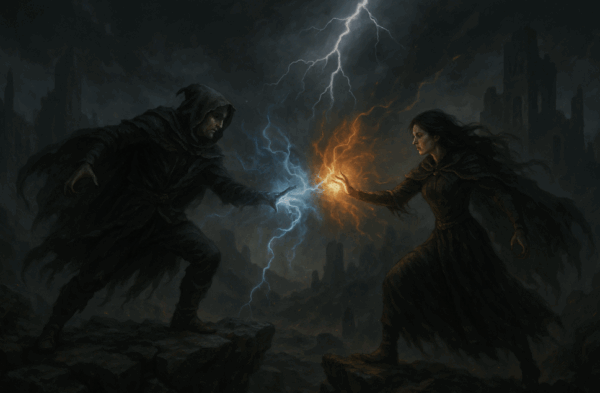Writing from a child’s perspective is a bit like trying to remember where you put your keys—tricky at first, but when you get it right, everything clicks into place. When it comes to middle-grade fiction, the stakes are high. Younger readers are some of the toughest critics. If you don’t get the voice just right, they’ll see through it faster than a teacher spotting gum under a desk.
Capturing an authentic child’s voice isn’t just about simplifying vocabulary or dumbing down the plot; it’s about tapping into how kids see the world—full of wonder, confusion, and excitement. Capturing a child’s imagination is crucial for engaging young readers and making the story come alive, inspiring them to visualize themselves within the narrative.
In this article, we’ll explore how to master the art of writing from a child’s perspective, ensuring that your middle-grade novel speaks to the heart of your readers (without sounding like you’re trying too hard to be the cool parent at school drop-off).
Understanding the Child’s Perspective in Middle-Grade Fiction
Middle-grade fiction is written for readers aged 8 to 12, and those are some of the most formative emotional and cognitive years. Children this age are figuring out who they are, what they care about, and how to navigate a world that’s getting bigger by the day. To write from a child’s perspective, you need to remember that their worldview is limited, but in their eyes, it’s all-encompassing.
The main character in middle-grade fiction should be relatable and of a similar age to the target readers, allowing them to connect through shared experiences such as friendship, identity exploration, and coming of age.
Your Publishing Journey Awaits – Start NowWhile adults may focus on the big picture, kids ignore the details. A lost lunchbox might feel like the end of the world, while a spontaneous adventure with friends could feel like the beginning of something magical. The key is to tap into that emotional landscape and reflect it in your writing. Some beloved middle-grade books, like Wonder and Percy Jackson, bring that childlike sense of awe and frustration to life by reflecting experiences that children encounter in their own lives.
Understanding Middle-Grade Readers
When it comes to understanding the capabilities of middle-grade readers, those vibrant minds aged 8 to 12, are a fascinating and diverse bunch. This age group is a melting pot of interests, reading levels, and maturity stages. For authors and publishers aiming to captivate this audience, understanding their unique characteristics is paramount.
Age range and reading level
Middle-grade readers typically fall within the upper elementary to middle school bracket. Their reading levels can vary widely, but most middle-grade books are crafted for a 4th to 7th-grade reading level. This period is crucial for honing reading skills, and middle-grade books play a pivotal role in shaping their literary tastes and habits. The word count of middle-grade novels is also important, varying between lower and upper middle-grade categories to match the target age group and themes, which significantly influences reader engagement and narrative development.
Interests and preferences of middle-grade readers
What do middle-grade readers love? They’re drawn to stories with relatable characters, thrilling plots, and genuine themes. They want to see characters who face the same challenges they do—friendship woes, family dynamics, and the journey of self-discovery. Many also have a penchant for the magical and fantastical, enjoying tales that whisk them away to other worlds, or stories that delve into complex social issues with a touch of adventure.
Importance of authenticity and relatability
Authenticity and relatability are the golden tickets to a middle-grade reader’s heart. These young readers have a keen sense of spotting inauthenticity. They crave stories that feel real, with characters who think, feel, and act like they do. Authors must dive deep into the middle-grade psyche, tackling tough topics with honesty and accessibility, ensuring their stories resonate on a personal level.
The Role of Age Appropriateness in Middle-Grade Novels
It’s no secret that kids grow up fast, but middle-grade readers are still navigating the transition between childhood and adolescence. They’re old enough to grasp more complex themes but young enough to still be enchanted by a sense of adventure and wonder. When writing for this age group, it’s crucial to find that balance between relatable content and age-appropriate storytelling.
For example, middle-grade books often tackle real-world challenges like friendship, bullying, or family dynamics from a child’s viewpoint. Keep the lessons subtle and the drama believable, without veering into the complexities better suited for young adult fiction. Age-appropriate topics ensure that readers stay engaged without feeling overwhelmed.
Choosing the Right Narrative Voice: First Person or Third Person
Choosing between first-person and third-person narrative is like deciding whether to eat cake with a fork or a spoon—there’s no wrong answer, but each has its own advantages. In a first-person narrative, readers get direct access to the thoughts and emotions of the protagonist, which can make the story feel more personal and immediate. It’s a great choice when you want readers to experience the world through the eyes of your young protagonist. Just remember, kids often have a limited understanding of adult situations, which can add a layer of humor or tension to the narrative.
On the other hand, a third-person narrative allows you to offer a wider perspective while still keeping the child at the center of the story. This approach is useful if you want to explore multiple points of view or give readers insight into other characters. It also lets you switch between moments of grand adventure and more intimate, emotional beats, creating a fuller picture of the protagonist’s world.
The Unreliable Narrator in Middle-Grade Fiction
Ah, the unreliable narrator—a tool as tricky as convincing a kid that broccoli is a treat. Children don’t always see the world clearly, and that’s what makes this narrative device so useful. Whether it’s due to a lack of experience, age groups, or misunderstanding, children often misinterpret situations, which can lead to humorous or even touching moments.
Using an unreliable child narrator allows you to build layers into your story. For example, the child might think they’re embarking on a grand quest to save the world, while readers (and adults in the story) realize that they’re simply trying to find the family dog. Books like The True Story of the Three Little Pigs or Because of Winn-Dixie expertly use this technique to show the gap between what the child narrator believes and what’s really happening.
Your Publishing Journey Awaits – Start NowCreating a Child Narrator
Creating a believable child narrator is crucial in middle-grade fiction. To achieve this, authors can use various techniques to develop a child character that resonates with young readers.
Techniques for developing a believable child character
- Observe Children: Spend time around children in your target age group. Watch how they interact, the words they use, and their body language. This firsthand observation will help you create a more authentic and relatable child narrator.
- Use Child-Like Language: Kids have their own way of speaking. They might use simpler words, shorter sentences, and sometimes even make up their own expressions. Avoid complex vocabulary or sentence structures that might sound unnatural to a child. Instead, aim for dialogue that feels genuine and true to their age.
- Show Their Emotions: Children are still learning to navigate their emotions, and they often wear their hearts on their sleeves. Show their emotional struggles and vulnerabilities. Whether it’s the joy of a new friendship or the sting of a playground insult, these moments will help readers connect with the child narrator on a deeper level.
- Make Them Relatable: Give your child narrator universal desires, hopes, and fears that young readers can identify with. Whether it’s the fear of being left out or the excitement of a new adventure, these relatable experiences will help readers invest in the character’s journey and root for them.
Balancing Innocence and Insight
When creating a child narrator, it’s essential to balance their innocence with insight. Children are still learning about the world, but they also have a unique perspective on life.
- Avoid Being Too Preachy: While it’s important to convey meaningful themes and messages, avoid being too preachy or didactic. Children are more likely to absorb lessons through storytelling rather than lectures. Let the story do the teaching.
- Show Their Growth: As the story progresses, show how the child narrator learns and grows from their experiences. This will help readers see the character’s development and maturity, making their journey more compelling.
- Leverage Their Innocence to Highlight Themes: Use the child narrator’s innocence to highlight important themes and issues. This can be a powerful way to convey complex ideas in a way that’s accessible to young readers. For example, a child’s simple question can sometimes reveal profound truths about the world.
Key Elements of Middle-Grade Books
Middle-grade books are a delightful blend of genres, themes, and narrative voices, each element contributing to a rich reading experience.
Genre and themes
Middle-grade books cover a broad spectrum of genres, from fantasy and science fiction to mystery and realistic fiction. They often weave in complex themes like identity, community, and social justice in an age-appropriate way, offering readers a layered and thought-provoking journey.
Popular genres and themes in middle-grade books include:
- Fantasy and Adventure: Stories filled with magical creatures, epic quests, and grand battles.
- Science Fiction: Tales that explore the fascinating intersection of technology and humanity.
- Mystery and Detective: Books that challenge readers to solve puzzles and uncover secrets.
- Realistic Fiction: Narratives that delve into the everyday complexities of life, touching on family, friendship, and social relationships.
By grasping these key elements, authors and publishers can craft middle-grade books that not only captivate but also shape the reading preferences and habits of this dynamic age group.
Crafting Dialogue That Sounds Like a Child’s Voice
Here’s the thing about writing dialogue for kids: they don’t talk like mini-adults. Sure, they might throw in the occasional big word to impress their friends (or confuse their parents), but for the most part, their conversations are straightforward and to the point. To make your dialogue believable for young readers, avoid overly complex language or adult speech patterns. That doesn’t mean you need to reduce their vocabulary to baby talk, just keep it natural.
The key is to listen to how kids talk. They often speak in shorter sentences and may jump from topic to topic without warning. Pay attention to the quirks and idiosyncrasies in their speech—this will help make your characters feel more genuine. Remember, your goal is to capture the cadence and rhythm of a child’s voice, so it feels like readers are listening to the words of an actual kid, not a 40-year-old in disguise.
Reflecting a Child’s Imagination and Sense of Adventure
One of the most wonderful things about middle-grade fiction is the chance to dive into a child’s wild imagination. Kids view the world with a sense of adventure that’s often lost in adulthood. Chapter books serve as a crucial developmental stage, helping young readers transition from picture books to middle-grade novels. These books, with their simpler vocabulary and plot structure, prepare children for the more complex themes and longer narratives found in middle-grade fiction. Whether they’re imagining an epic space battle during recess or thinking up elaborate schemes to save their lives during summer vacation, their creative energy knows no bounds.
Your Publishing Journey Awaits – Start NowWhen writing from a child’s perspective, make sure to lean into that sense of adventure. Let your protagonist’s imagination run wild and don’t be afraid to blur the lines between reality and fantasy. This is especially important in genres like science fiction or fantasy, where the rules of the real world don’t always apply. Books like The Phantom Tollbooth and The Chronicles of Narnia are great examples of how to let a child’s imagination guide the narrative.
Avoiding Common Pitfalls
When writing a middle-grade novel, there are several common pitfalls to avoid. By being aware of these pitfalls, authors can create a more engaging and effective story.
- Avoid Talking Down to Readers: Middle-grade readers are intelligent and capable of understanding complex ideas. Avoid talking down to them or using overly simplistic language. Instead, respect their ability to grasp nuanced concepts and present them in an age-appropriate manner.
- Don’t Be Too Predictable: Middle-grade readers love surprises and unexpected twists. Avoid being too predictable or formulaic in your storytelling. Keep them on their toes with plot twists and turns that keep the story exciting and engaging.
- Show, Don’t Tell: Rather than telling readers what’s happening, show them through action, dialogue, and description. This will help readers become more engaged in the story. For example, instead of saying a character is scared, show them trembling or hesitating before taking a step.
- Avoid Stereotypes: Avoid using stereotypes or clichés when creating characters. Instead, focus on creating unique and nuanced characters that readers can relate to. Give your characters depth and individuality, making them feel like real people with their own quirks and complexities.
By following these tips and avoiding common pitfalls, authors can create a compelling and engaging middle-grade novel that resonates with young readers.
Balancing the Child’s Perspective with Themes That Appeal to Young Readers
While children’s books should capture the voice and imagination of their protagonists, they also need to resonate with young readers on a deeper level. Themes like friendship, loyalty, and self-discovery are universal, but in middle-grade fiction, these themes need to be explored in ways that feel accessible and relevant to kids. That means the themes should emerge naturally from the story, without feeling like a heavy-handed lesson.
Middle-grade readers are savvy—they can smell a moral lesson a mile away. To avoid this, focus on the character’s journey, and let the themes reveal themselves through their experiences. Whether it’s learning to stand up to a bully or finding the courage to try something new, these moments will resonate more when they come from the character’s growth rather than an obvious message.
Conclusion: Mastering the Middle-Grade Voice
In middle-grade fiction, the child’s perspective is more than just a narrative choice—it’s the key to creating a story that resonates with younger readers. By embracing the unique ways children see the world, you can craft authentic, engaging, and full-of-heart stories. Whether you’re writing in first person or third person, or experimenting with unreliable narrators, remember to stay true to the voice of your protagonist.
So, go ahead—channel your inner 10-year-old, tap into that boundless imagination, and start writing books that will inspire young readers to turn the page. And don’t worry—if you lose your way, just think like a kid: there’s always an adventure waiting around the next chapter.
Ready to bring your middle-grade story to life? Try Spines’ free manuscript review tool and take the first step toward publishing your book today!
Your Publishing Journey Awaits – Start Now







